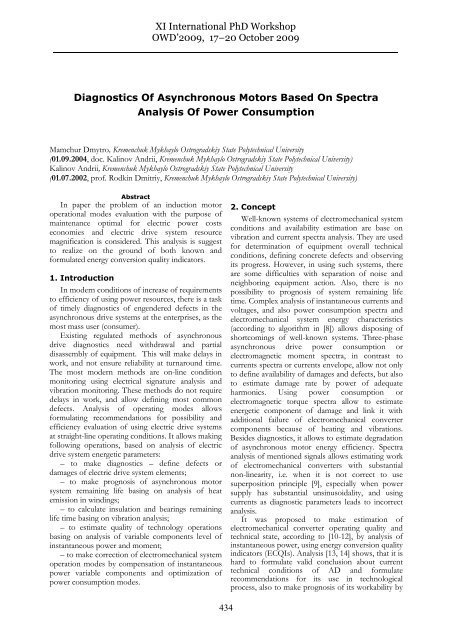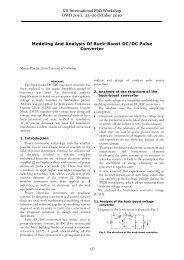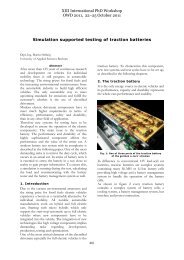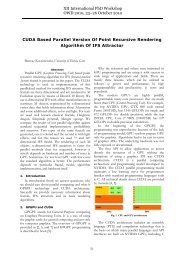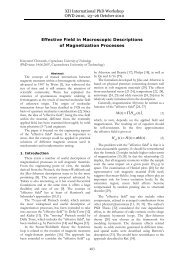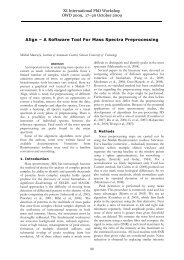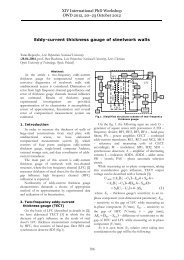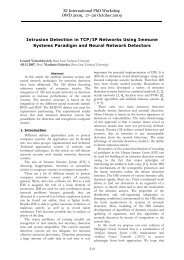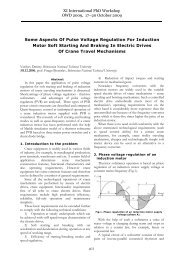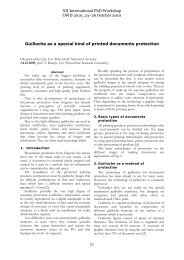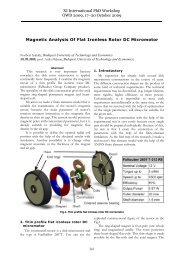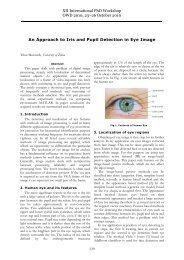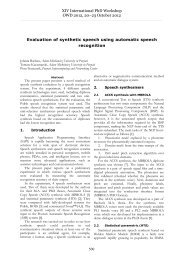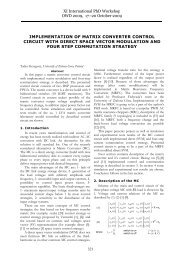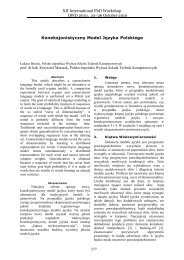Diagnostics Of Asynchronous Motors Based On Spectra Analysis Of ...
Diagnostics Of Asynchronous Motors Based On Spectra Analysis Of ...
Diagnostics Of Asynchronous Motors Based On Spectra Analysis Of ...
You also want an ePaper? Increase the reach of your titles
YUMPU automatically turns print PDFs into web optimized ePapers that Google loves.
<strong>Diagnostics</strong> <strong>Of</strong> <strong>Asynchronous</strong> <strong>Motors</strong> <strong>Based</strong> <strong>On</strong> <strong>Spectra</strong><br />
<strong>Analysis</strong> <strong>Of</strong> Power Consumption<br />
Mamchur Dmytro, Kremenchuk Mykhaylo Ostrogradskiy State Polytechnical University<br />
(01.09.2004, doc. Kalinov Andrii, Kremenchuk Mykhaylo Ostrogradskiy State Polytechnical University)<br />
Kalinov Andrii, Kremenchuk Mykhaylo Ostrogradskiy State Polytechnical University<br />
(01.07.2002, prof. Rodkin Dmitriy, Kremenchuk Mykhaylo Ostrogradskiy State Polytechnical University)<br />
Abstract<br />
In paper the problem of an induction motor<br />
operational modes evaluation with the purpose of<br />
maintenance optimal for electric power costs<br />
economies and electric drive system resource<br />
magnification is considered. This analysis is suggest<br />
to realize on the ground of both known and<br />
formulated energy conversion quality indicators.<br />
1. Introduction<br />
In modern conditions of increase of requirements<br />
to efficiency of using power resources, there is a task<br />
of timely diagnostics of engendered defects in the<br />
asynchronous drive systems at the enterprises, as the<br />
most mass user (consumer).<br />
Existing regulated methods of asynchronous<br />
drive diagnostics need withdrawal and partial<br />
disassembly of equipment. This will make delays in<br />
work, and not ensure reliability at turnaround time.<br />
The most modern methods are on-line condition<br />
monitoring using electrical signature analysis and<br />
vibration monitoring. These methods do not require<br />
delays in work, and allow defining most common<br />
defects. <strong>Analysis</strong> of operating modes allows<br />
formulating recommendations for possibility and<br />
efficiency evaluation of using electric drive systems<br />
at straight-line operating conditions. It allows making<br />
following operations, based on analysis of electric<br />
drive system energetic parameters:<br />
– to make diagnostics – define defects or<br />
damages of electric drive system elements;<br />
– to make prognosis of asynchronous motor<br />
system remaining life basing on analysis of heat<br />
emission in windings;<br />
– to calculate insulation and bearings remaining<br />
life time basing on vibration analysis;<br />
– to estimate quality of technology operations<br />
basing on analysis of variable components level of<br />
instantaneous power and moment;<br />
– to make correction of electromechanical system<br />
operation modes by compensation of instantaneous<br />
power variable components and optimization of<br />
power consumption modes.<br />
XI International PhD Workshop<br />
OWD’2009, 17–20 October 2009<br />
434<br />
2. Concept<br />
Well-known systems of electromechanical system<br />
conditions and availability estimation are base on<br />
vibration and current spectra analysis. They are used<br />
for determination of equipment overall technical<br />
conditions, defining concrete defects and observing<br />
its progress. However, in using such systems, there<br />
are some difficulties with separation of noise and<br />
neighboring equipment action. Also, there is no<br />
possibility to prognosis of system remaining life<br />
time. Complex analysis of instantaneous currents and<br />
voltages, and also power consumption spectra and<br />
electromechanical system energy characteristics<br />
(according to algorithm in [8]) allows disposing of<br />
shortcomings of well-known systems. Three-phase<br />
asynchronous drive power consumption or<br />
electromagnetic moment spectra, in contrast to<br />
currents spectra or currents envelope, allow not only<br />
to define availability of damages and defects, but also<br />
to estimate damage rate by power of adequate<br />
harmonics. Using power consumption or<br />
electromagnetic torque spectra allow to estimate<br />
energetic component of damage and link it with<br />
additional failure of electromechanical converter<br />
components because of heating and vibrations.<br />
Besides diagnostics, it allows to estimate degradation<br />
of asynchronous motor energy efficiency. <strong>Spectra</strong><br />
analysis of mentioned signals allows estimating work<br />
of electromechanical converters with substantial<br />
non-linearity, i.e. when it is not correct to use<br />
superposition principle [9], especially when power<br />
supply has substantial unsinusoidality, and using<br />
currents as diagnostic parameters leads to incorrect<br />
analysis.<br />
It was proposed to make estimation of<br />
electromechanical converter operating quality and<br />
technical state, according to [10-12], by analysis of<br />
instantaneous power, using energy conversion quality<br />
indicators (ECQIs). <strong>Analysis</strong> [13, 14] shows, that it is<br />
hard to formulate valid conclusion about current<br />
technical conditions of AD and formulate<br />
recommendations for its use in technological<br />
process, also to make prognosis of its workability by
formulated ECQIs. Thus, there is necessity of<br />
increasing existing ECQIs for possibility, basing on<br />
it, diagnostics and analysis of AD operation modes.<br />
It may be done by using analysis of power<br />
consumption spectra.<br />
3. Implementation<br />
3.1 Science objective<br />
Development of asynchronous drives defects<br />
detecting method based on analysis of power<br />
consumption spectra.<br />
3.2 Experimental results<br />
Deterioration of asynchronous motor operation<br />
modes appears because of electrical or mechanical<br />
damages, or bad supply (asymmetry, unsinusoidality).<br />
Electrical damages are caused by windings, AD's<br />
nonlinearity, AD's parametric asymmetry, static and<br />
dynamic unbalance. Mechanical damages are caused<br />
by physical damages, rotor bending, bearings<br />
slumping, bad mounting. For influence analysis of<br />
different kinds of damages and unsoundness of<br />
energy conversion process, the following three-phase<br />
mathematical models of AD were developed and<br />
investigated [15]:<br />
- idealized motor fed with poor voltage;<br />
- motor with improper mounting [16];<br />
- motor with static, dynamic and combined rotor<br />
misbalance [17];<br />
- motor with stator winding asymmetry;<br />
- motor with rotor winding bar break [18];<br />
- motor with stator winding short-circuits.<br />
Using these models for AD 4АХБ2Г100L4 (4<br />
kilowatt; 8.7 А; 1420 rpm) running-in, idling and<br />
different loading operations were calculated.<br />
Operation modes were analyzed by three-phase and<br />
each phase power spectra (fig. 1 – 7), where different<br />
harmonics are individual for different damages [19].<br />
Whereas some kinds of damages can become<br />
apparent by subharmonics [20], which are symmetric<br />
relatively to main harmonic [19], three-phase power<br />
spectrum was separated to such zones for analysis:<br />
– 0–5 Hz – zone of constant component;<br />
– 6–45 Hz – zone of low-frequency component;<br />
– 46–55 Hz – zone of power supply main<br />
frequency;<br />
– 56–95 Hz – contiguous zone of power supply<br />
main frequency and double frequency;<br />
– 96–105 Hz – zone of double power supply<br />
main frequency.<br />
By analogy: 106–195 Hz, 206–295 Hz, >306 Hz<br />
– contiguous zones; 196–205 Hz, 296–305 Hz, 396–<br />
405 Hz, 496–505 Hz, 596–605 Hz – zones of<br />
multiply main frequency. For estimation of different<br />
frequencies harmonics contribution to integral value<br />
of hi-harmonics, the following quotient was used:<br />
K<br />
harm(<br />
N1÷<br />
N2<br />
)<br />
=<br />
N2<br />
2<br />
∑Pk<br />
1<br />
k1=<br />
N1<br />
N −1<br />
2<br />
∑ Pk<br />
k=<br />
1<br />
where N – total amount of spectra harmonics, N1,<br />
N2 – initial and final harmonics values.<br />
,<br />
435<br />
Additional analysis was carried out by ECQIs,<br />
formulated in previous researches[10-12]. The<br />
following factors were chosen among them:<br />
– the factor of the energy consumption efficiency:<br />
ε – the generalized factor describing low-quality<br />
p<br />
conversion integrally, ε pi – the factor describing<br />
low-quality energy conversion specified by phase,<br />
here i – number of phase;<br />
– the factor, characterizing inequality of heat<br />
generation in the stator windings, K npτ<br />
;<br />
– the reciprocal factor of low-quality torque<br />
conversion Krec t = 1/<br />
Klq<br />
t – describing percent of<br />
hi-harmonics in torque spectra;<br />
– the factor of the vibration characteristics<br />
deterioration Klq v .<br />
Considerable torque variable component is<br />
usually created by serious damages. That's why it is<br />
necessary to make additional analysis to detect its<br />
source. <strong>Analysis</strong> of experimental data [7] shows, that<br />
operation of electromechanical systems, where<br />
torque variable component is greater than 15% of<br />
nominal value, results in an intensive resource<br />
decreasing and such modes are undesirable. Limiting<br />
values of torque variable component must be<br />
determined subject to engine power and system<br />
operation modes. To account these facts, quotient of<br />
electromagnetic torque hi-harmonics is proposed:<br />
N<br />
∑ −<br />
1<br />
Kt hh = Mν<br />
Klim<br />
Mn<br />
,<br />
ν = 1<br />
where K lim – maximum permissible value of<br />
torque variable component comparatively to torque<br />
nominal value, M n – nominal value of torque. When<br />
this quotient is greater than one, such regimes are<br />
damaging for machines. In ideal, electromagnetic<br />
moment signal has no hi-harmonics, and quotient is<br />
zero.<br />
For estimation of total machine asymmetry<br />
caused by both bad voltage and machine low-quality,<br />
weighted average quotients for amplitudes and<br />
phases of instantaneous power were proposed:<br />
Pavg i = Piν<br />
( Pav<br />
+ Pbv<br />
+ Pcv<br />
) ;<br />
ν<br />
ϕavg i = ϕiν<br />
( ϕav<br />
+ ( ϕbv<br />
+ 2π / 3)<br />
+ ( ϕc<br />
v + 4π<br />
/ 3))<br />
ν<br />
– ratio of one-phase harmonic or phase value to<br />
total three-phase harmonic or phase value of same<br />
rank. Ideally, quotient is 1/3 by each of three phases<br />
[5]. Well-behaved analysis is whenν = 2 , because<br />
this harmonic is always present in signal with<br />
different kinds of low-quality.<br />
When diagnostics in real work conditions with<br />
real power network is made, reduction to supply<br />
from ideal power network must be done [21], or<br />
electric energy quality indicators (EEQI) must be<br />
taken into account [22]. For this, indicators of<br />
voltage asymmetry ε 2 , indicator of current<br />
asymmetry ε I 2,<br />
indicator of power asymmetry ε P2 ,<br />
k , indicator<br />
indicator of voltage unsinusoidality us U<br />
of current unsinusoidality us I<br />
2<br />
k were calculated.
Variation of ECQIs, when used different load or<br />
technological process conditions, are information<br />
attributes when estimation of asynchronous motor<br />
system working modes is performed. However,<br />
values of these quotients must not be rigidly<br />
referenced with value of load, because diagnostic<br />
operation is carried out under no-load conditions or<br />
with unknown or stochastic changing load.<br />
Analyzing whole quotients and power spectra, the<br />
following conclusions can be made.<br />
In three-phase power spectra of non-damaged<br />
motor there is just negligible value of low-frequent<br />
component stipulated by mathematical convertion<br />
errors when mathematical models were calculated. In<br />
phase power spectra there is main component of<br />
double voltage frequency ( 2 fv<br />
=100 Hz), and<br />
negligible subharmonics of double voltage frequency<br />
and single voltage frequency ( f v =50 Hz) (fig. 1, b),<br />
which is also stipulated by mathematical convertion<br />
errors. Main percent of high harmonics is in range of<br />
6–45 Hz (fig. 1, a). As motor is without damages, so<br />
quotients have limited values for ideal machine. So,<br />
if there is just negligible low-frequent component in<br />
spectra of three-phase power and formulated<br />
quotients are maximally near optimal values, that<br />
examined motor is good.<br />
a) b)<br />
Fig.1 Three-phase (a) and phase A (b) instantaneous power<br />
spectra of idealized motor without damages with ideal supply.<br />
436<br />
K τ = 1 for all phases, it means unsinusoidality<br />
np ( i )<br />
of power supply. When harmonic of frequency 4 f v<br />
is significant, it means that power supply system is<br />
also asymmetric.<br />
(<br />
a) b)<br />
c)<br />
Fig. 2 Three-phase power spectra with non-sinusoidal<br />
supply: a) 1, 3 harmonics; b) 1,3,5 harmonics; c) 1,3,5<br />
harmonics, non-symmetry of amplitudes of 5-th harmonics by<br />
phases.<br />
( K<br />
So, if the following rule is correct:<br />
> 0 ) ∧(<br />
K = K = K<br />
ε 2<br />
npτ<br />
(A) npτ<br />
(B) npτ<br />
(C)<br />
∧ ( ε > 0,<br />
9)<br />
∧(<br />
ε<br />
P<br />
t hh<br />
PA<br />
> 0,02) ∧(<br />
P<br />
≈ ε<br />
avg А2<br />
PB<br />
= P<br />
≈ ε<br />
avg B2<br />
) ∧<br />
= P<br />
≈ 1)<br />
avg C 2<br />
= 0,<br />
33)<br />
∧ ( Kharm(296<br />
- 305) ≈ 1)<br />
= 1,<br />
that examined motor is good, but power supply is<br />
symmetric and non-sinusoidal, and if the following<br />
rule is correct:<br />
( > 0 ) ∧(<br />
K = K = K ≈ 1)<br />
∧ ( ε > 0,<br />
9)<br />
∧(<br />
ε<br />
p<br />
pA<br />
pB<br />
PС<br />
ε 2<br />
npτ<br />
(A) npτ<br />
(B) npτ<br />
(C)<br />
≠ ε<br />
≠ ε<br />
pС<br />
) ∧ ( K<br />
t hh<br />
> 0,02 ) ∧<br />
Thus, if the following rule is correct:<br />
( ε 2 = 0 ) ∧ ( ε p2<br />
= 0 ) ∧ ( Knpτ<br />
(A) = Knpτ<br />
(B) =<br />
= K npτ<br />
(C) = 1)<br />
∧ ( ε p ≈ 1)<br />
∧ ( ε pA = ε pB = ε pС )<br />
∧ ( Pavg<br />
А ≠ Pavg<br />
B ≠ Pavg<br />
C ) ∧(<br />
Kharm(296-<br />
305) ≈ 1)<br />
2<br />
2<br />
2<br />
3<br />
∧ ( Kharm(196-<br />
205) > Kharm(146-195)<br />
⋅10<br />
) = 1,<br />
that examined motor is supplied by asymmetric nonsinusoidal<br />
system.<br />
∧ ( Krec<br />
t ≈ 1)<br />
∧ ( Kt<br />
hh < 0,<br />
05 ) ∧<br />
( Pavg<br />
А = Pavg<br />
B = Pavg<br />
C = 0,<br />
33)<br />
∧<br />
2<br />
2<br />
2<br />
( Kharm(6<br />
- 45) > 0,<br />
75 ) = 1,<br />
that examined motor is good, and it has ideal supply.<br />
When there is unsinusoidality of supply system<br />
(3-rd harmonic), appears harmonic with frequency of<br />
6 f v (fig. 2, a) in three-phase power spectra. When<br />
there are 3-rd and 5-th harmonics of power supply,<br />
in spectra of three-phase power spectra appears<br />
subharmonics of 6 f v harmonic (fig. 2, b). When<br />
there are both unsinusoidality and asymmetry of<br />
power supply, appears harmonics of all frequencies,<br />
which are multiple of double power supply<br />
frequency (fig. 2, c). Herewith, harmonics specific<br />
for motor without damages, are constant by values<br />
of frequency and amplitude. Main percent of high<br />
harmonics, when there is unsinusoidality of power<br />
supply, is in frequency of 6 f v (fig. 2). When there is<br />
To simplify logical expressions, it is appropriate<br />
to previously transform analyzed signals to signals,<br />
which are received with ideal power supply [21]. In<br />
this case, indicators ε 2 , k us U will always be zero,<br />
and it is not necessary to take them into account<br />
when rules are composing.<br />
When mounting is bad, there is only low<br />
frequency three-phase power spectra harmonics<br />
(fig. 3, a) conditioned by low-frequent motor<br />
vibrations. In phases power spectra there is main<br />
harmonic with double voltage frequency and<br />
subharmonics of single and double voltage frequency<br />
(fig. 3, b). When mounting is worse, frequencies of<br />
subharmonics changes, and their amplitudes grow.<br />
Formulated indicators changes are negligible (1–2%).<br />
This effect can be explained by approaching to<br />
hunting frequency whith different quality of<br />
mounting. Main percent of high harmonics is in<br />
range of 6–45 Hz (fig. 3, a). Thus, if there is<br />
significant low-frequent component in three-phase<br />
asymmetry, harmonics of frequency 4 f v become<br />
significant (fig. 2, c). Thus, if in three-phase power<br />
power spectra and growth of indicator K t hh with<br />
mounting degradation, with almost optimal other<br />
spectrum there is harmonic of frequency 6 f v , and indicators, that motor has bad mounting.
( K<br />
a) b)<br />
Fig. 3 Three-phase (a) and phase A (b) spectra of motor<br />
with bad mounting.<br />
So, if the following rule is correct:<br />
npτ<br />
(A)<br />
∧ ( P<br />
avg А2<br />
= K<br />
= P<br />
npτ<br />
(B)<br />
avg B2<br />
= K<br />
= P<br />
npτ<br />
(C)<br />
avg C 2<br />
= 1)<br />
∧ ( K<br />
= 0,<br />
33)<br />
∧<br />
t hh<br />
> 0,<br />
02)<br />
∧<br />
∧ ( ε pA = ε pB = ε pС ) ∧ ( K harm(6-<br />
45) > 0,<br />
75)<br />
= 1,<br />
that examined motor is badly mounted.<br />
When rotor is dynamic or static misbalanced,<br />
there is harmonic in three-phase power spectra,<br />
which relates to rotation frequency. Thus, when noload,<br />
there is harmonic with frequency 100p in threephase<br />
power spectra (here p – number of ports). So,<br />
if there is significant component with rotation<br />
frequency in three-phase power spectra, and<br />
weighted average quotients are not equivalent by<br />
phases, that motor has asymmetry. And if there is<br />
significant value of harmonic amplitudes of 156–<br />
195 Hz, that asymmetry is caused by unbalance.<br />
a) b)<br />
Fig. 4 Three-phase (a) and phase A (b) power spectra of<br />
motor with rotor unbalance.<br />
So, for detecting rotor unbalance, the following<br />
rule should be true:<br />
( ε > 0,<br />
05)<br />
∧ ( ε ≠ ε ≠ ε<br />
p2<br />
∧ ( P<br />
avg А2<br />
≠ P<br />
avg B2<br />
pA<br />
≠ P<br />
pB<br />
avg C 2<br />
) ∧ ( K<br />
) ∧ ( K<br />
t hh<br />
harm(156-195)<br />
> 0,<br />
02)<br />
> 0,<br />
1)<br />
∧ ( Kharm(196-<br />
205) > 0,<br />
45)<br />
= 1.<br />
In case of stator windings asymmetry and stator<br />
windings short-circuits, there is significant harmonics<br />
of double voltage frequency and little less then 4 f v<br />
frequency (fig. 5 a, fig. 6, a). When damages are<br />
worse, this harmonics grow. Low-frequency<br />
harmonics (5–45 Hz) also grow, however its<br />
frequency is constant. Main percent of high<br />
harmonics for phases is in range of 96–105 Hz. Also<br />
significant percent is from range of 196–205 Hz (fig.<br />
5, b; fig. 6, b). When both kinds of damages are<br />
caused, values of formulated indicators are almost<br />
equal. Thus, if there is main harmonic with double<br />
voltage frequency and significant harmonic of little<br />
less then 4 f v frequency, and significant degradation<br />
of formulated indicators, that there is windings<br />
asymmetry or windings short-circuits.<br />
a) b)<br />
Fig. 5 Three-phase (a) and phase A (b) spectra of motor<br />
with asymmetry of phase A.<br />
pС<br />
(<br />
437<br />
( K<br />
( P<br />
(( K<br />
a) b)<br />
Fig. 6 Three-phase (a) and phase A (b) spectra of motor<br />
with stator winding short circuits.<br />
So, if the following rule is correct:<br />
> 0,<br />
02)<br />
∧ ( K ≠ K ≠ K<br />
ε p2<br />
npτ<br />
(A) npτ<br />
(B) npτ<br />
(C)<br />
∧ ( ε < 0,<br />
98)<br />
∧ ( ε<br />
p<br />
lq v<br />
avg А2<br />
> 0,<br />
05)<br />
∧ ( K<br />
harm(196<br />
≠ P<br />
avg B2<br />
- 205)<br />
> K<br />
pA<br />
rec t<br />
≠ P<br />
≠ ε<br />
< 0,<br />
97)<br />
∧<br />
avg C 2<br />
pB<br />
harm(156-195)<br />
≠ ε<br />
) ∧ (( K<br />
) ∨<br />
pС<br />
) ∧<br />
harm(96-105)<br />
)<br />
> 0,<br />
99)<br />
∧<br />
( Kharm(196-<br />
205) ≈ Kharm(156-195)<br />
)) = 1,<br />
then there is either windings asymmetry or windings<br />
short-circuits.<br />
When rotor bar breaks, there is only low<br />
frequency component in three-phase power spectra<br />
(fig. 7, a). It grows when progresses defect.<br />
Remaining indicators change negligibly and there is<br />
no asymmetry of examined parameters, because<br />
changing of rotor parameters appears indirect in<br />
changing of stator parameters. Additional indicator<br />
for identifying this defect is subharmonics of voltage<br />
frequency in current spectra [3]. Thus, if there is low<br />
frequency component of three-phase power signal,<br />
also subharmonics of main voltage frequency<br />
harmonic in current spectra, non-equal weighted<br />
average quotients and almost optimal ε p , K rec t ,<br />
then motor has rotor bar breaks.<br />
a) b)<br />
Fig. 7 Three-phase (a) and phase A (b) spectra of motor<br />
with rotor winding bar break.<br />
For detecting this defect, the following rule must<br />
be correct:<br />
( K ≠ K ≠ K ) ∧ ( ε ≈ ε ≈ ε )<br />
npτ<br />
(A)<br />
∧ ( K<br />
t hh<br />
npτ<br />
(B)<br />
> 0,<br />
02 ) ∧ ( P<br />
npτ<br />
(C)<br />
avg А2<br />
≠ P<br />
pA<br />
avg B2<br />
≠ P<br />
pB<br />
avg C 2<br />
) ∧<br />
∧ ( Kharm(6<br />
- 45) > 0,<br />
8 ) = 1.<br />
Thus, observing for variation of formulated<br />
indicators, it is possible to make conclusion about<br />
appearing of some kinds of defects or non-qualities<br />
of asynchronous electric drive systems. Analyzing<br />
values of some indicators it is possible to make<br />
conclusion about current work mode allowability.<br />
Also it is possible to prognosis remaining resource<br />
analyzing non equal phase heating basis on "eight<br />
degree" rule. When some defects are present for one<br />
motor at the same time, percent of harmonics from<br />
frequency ranges for each defect will be less than if it<br />
pС
would be only one defect. Determination of defects<br />
must be done by additional indicators, however if<br />
defect is present, value of indicator Kharm(<br />
N1<br />
÷ N 2 )<br />
must be greater than 0.1. Biggest value of high<br />
harmonics indicator for one of frequency diapasons<br />
imply about domination of this defect.<br />
Theoretical conclusions and mathematical models<br />
analysis results were vindicated by experimental<br />
testing [23].<br />
Analyzing experimental data of testing AD with<br />
bad mounting supplying symmetrical and<br />
asymmetrical voltage, the following conclusions were<br />
made:<br />
– when bad mounting, there is low frequent<br />
component of three-phase power spectra (fig. 8).<br />
This fact vindicates model analysis results;<br />
Fig. 8 – Power consumption spectra when feeding<br />
3-phase symmetrical power supply.<br />
Fig. 10 – Voltage and current spectra for good motor.<br />
Fig. 12 – Voltage and current spectra for motor with break<br />
of three rotor winding bars.<br />
Fig. 14 – Voltage and current spectra for motor with stator<br />
winding short circuits (10% of phase A).<br />
4. Conclusion<br />
Additional indicators of energy conversion quality<br />
were proposed. Analyzing existing and proposed<br />
indicators, and also power consumption spectra,<br />
rules for detecting most popular kinds of AD defects<br />
were formulated.<br />
Bibliography<br />
[1] Котеленец Н.Ф., Кузнецов Н.Л. Испытания и<br />
надежность электрических машин.<br />
М.,“Высш.шк.”, 1988. – 232 с.<br />
[2] Ермолин Н.П., Жерихин И.П. Надежность<br />
электрических машин. М., “Энергия”, 1975. –<br />
250 с.<br />
438<br />
– harmonic with frequency value of double<br />
voltage frequency, generated by power supply<br />
asymmetry (fig. 8, 9).<br />
Analyzing experimental data for AD with stator<br />
and rotor damages, it is possible to make following<br />
conclusions:<br />
– when rotor winding damages, there is harmonic<br />
in three-phase power spectra (fig. 13) which conform<br />
to rotation frequency (here - 24.194 Hz), and there is<br />
subharmonics of voltage main harmonic frequency<br />
in current signal (fig. 12);<br />
– when stator windings short-circuits, there is<br />
low-frequency harmonics in three-phase power<br />
consumption spectra, like in modeling results<br />
(fig. 14, 15).<br />
Fig. 9 – Power consumption spectra when feeding 3-phase<br />
unsymmetrical power supply.<br />
Fig. 11 – Instantaneous power consumption spectra for<br />
good motor.<br />
Fig. 13 – Instantaneous power consumption spectra for<br />
motor with break of three rotor winding bars.<br />
1 . 10 4<br />
1 .10 3<br />
100<br />
10<br />
1 .10 3<br />
0 200 400 600 800 1000 1200<br />
0.1<br />
0.01<br />
Fig. 15 – Instantaneous power consumption spectra for<br />
motor with stator winding short circuits (10% of phase A).<br />
[3] Петухов В., Соколов В. Диагностика<br />
состояния электродвигателей. Метод<br />
спектрального анализа потребляемого тока.<br />
// Новости электротехники №1(31) 2005<br />
[4] B.Yazici, G.B.Kliman, W.J.Premerlani,<br />
R.A.Koegl, A.Abdel-Malek, G.B.Robinson <strong>On</strong>line<br />
statistical conditional monitoring and fault<br />
diagnosis for motors with applications to rotor<br />
bars and bearings // GE Research &<br />
Development center, September 1997<br />
[5] Aditya Korde B.E. <strong>On</strong>-line condition monitoring<br />
of motors using electrical signature analysis //<br />
presented at ‘Recent advances in condition-based<br />
plant maintenance’ seminar 17-18 May 2002<br />
[6] Internet resource:<br />
http://www.vibration.ru/sredstva.shtml
[7] Мамчур Д.Г., Калінов А.П. Оцінка режимів<br />
роботи асинхронних двигунів на основі<br />
показників якості перетворення енергії //<br />
Електромеханічні системи, методи<br />
моделювання та оптимізації. Збірник<br />
наукових праць VII ВНТК молодих учених і<br />
спеціалістів. – Кременчук, КДПУ, 2009. – 418<br />
с., - С. 244-249.<br />
[8] Kalinov Andriy, Mamchur Dmitriy, Chumachova<br />
Anna, Research <strong>Of</strong> The <strong>Asynchronous</strong> Motor’s<br />
Observability For Estimation Operating<br />
Conditions And Energy Efficiency // X<br />
International PhD Workshop OWD’2008, рр.<br />
357-362.<br />
[9] Бессонов Л.А. Теоретические основы<br />
электротехники. Электрические цепи:<br />
Учебник. – М.: Гардарики, 2001. – 638 с.<br />
[10] Чёрный А.П. Определение снижения ресурса<br />
асинхронных двигателей по показателям<br />
качества преобразования энергии // Збірник<br />
праць Кіровоградського НТУ, 2004. – Вип.<br />
15, – С. 160–168.<br />
[11] Родькин Д.И., Чёрный А.П., Мартыненко В.А.<br />
Обоснование критериев качества<br />
преобразования энергии в<br />
электромеханических системах // Проблемы<br />
создания новых машин и технологий. Сб. научных<br />
трудов КГПУ: Вып. 1. – Кременчуг,<br />
2002. – С. 81–85.<br />
[12] Родькин Д.И. Новая система показателей<br />
качества использования электрической<br />
энергии // Науковий вісник НГУ, 2004, –<br />
№3. – С. 20–26.<br />
[13] Чёрный А.П., Калинов А.П., Мамчур Д.Г.<br />
Применение показателей качества<br />
преобразования энергии для оценки<br />
состояния и надёжности электомеханических<br />
систем // Зб. наук. праць ДДТУ (техн. науки).<br />
Тематичний випуск «Проблеми<br />
автоматизованого електропривода. Теорія і<br />
практика». – Дніпродзержинськ: ДДТУ, 2007.<br />
– С. 519–523.<br />
[14] Мамчур Д.Г., Калинов А.П. Развитие<br />
показателей качества преобразования<br />
энергии для диагностики технического<br />
состояния асинхронных электродвигателей<br />
// Вісник КДПУ ім. М. Остроградського,<br />
Випуск 4/2008 (51). Частина 2. – С. 158–163.<br />
[15] Моделювання електромеханічних систем:<br />
Підручник / Чорний О.П., Луговой А.В.,<br />
Родькін Д.Й., Сисюк Г.Ю., Садовой О.В. –<br />
Кременчук, 2001. – 410 с.<br />
[16] Мамчур Д.Г. Дослідження вібрацій механічної<br />
частини електричних машин на<br />
математичних моделях // Тези доповідей<br />
п’ятої всеукр. НТК молод. вчен. і спец.<br />
“Електромеханічні системи методи<br />
моделювання та оптимізації”. Кременчук:<br />
КДПУ, 2007. – С. 60–61.<br />
[17] Калінов А.П., Мамчур Д.Г. Математичні<br />
моделі для дослідження впливу<br />
конструктивних несиметрій електричних<br />
машин на їх електромагнітні параметри //<br />
Вісник КДПУ. Наукові праці КДПУ. - Вип. 3<br />
(44). – Ч.2 - Кременчук: КДПУ, 2007. – С.<br />
150–154.<br />
[18] Калинов А.П., Ухань Ж.И., Топчиенко Ю.А.<br />
Исследование работы асинхронных<br />
двигателей при повреждении обмоток ротора<br />
// Тези диповідей шостої всеукр. НТК мол.<br />
вчен. і спец. “Електромеханічні системи<br />
методи моделювання та оптимізації”.<br />
Кременчук: КДПУ, 2008. – С. 73–74.<br />
[19] Петухов В., Соколов В. Диагностика<br />
состояния электродвигателей. Метод<br />
спектрального анализа потребляемого тока<br />
// Новости электротехники. – № 1(31). 2005.<br />
[20] Жежеленко И. В. Интергармоники сетевого<br />
тока непосредственных преобразователей<br />
частоты с искусственной коммутацией / И. В.<br />
Жежеленко, Ю. Л. Саенко, Т. К. Бараненко<br />
// Электрика. – 2005. – №5. – С. 16 – 22.<br />
Библиогр.: с. 22.<br />
[21] Калинов А.П., Мамчур Д.Г., Херардо Веласке<br />
Ангуло. Отделение влияния<br />
некачественности питающей сети на<br />
электрические машины переменного тока в<br />
задачах диагностики // Вісник НТУ «ХПІ»,<br />
«Проблеми автоматизованого<br />
електропривода. Теорія і практика» – Харків:<br />
НТУ «ХПІ», 2008, № 30. – С. 559-563.<br />
[22] Жежеленко И.В., Саенко Ю.Л. Вопросы<br />
качества электроэнергии в электроустановках.<br />
– Мариуполь: ПГТУ, 1996. – 173 с.<br />
[23] Калінов А.П., Мамчур Д.Г., Браташ О.В.,<br />
Ухань Ж.І., Простак О.І. Експериментальні<br />
дослідження режимів роботи асинхронних<br />
двигунів з неякісним кріпленням до основи та<br />
з пошкодженнями обмоток статора і ротора<br />
// Електромеханічні системи, методи<br />
моделювання та оптимізації. Збірник<br />
наукових праць VII ВНТК молодих учених і<br />
спеціалістів. – Кременчук, КДПУ, 2009. – 418<br />
с., - С. 250-253.<br />
439<br />
Authors:<br />
Mamchur Dmytro,<br />
Kremenchuk Mykhaylo<br />
Ostrogradskiy State<br />
Polytechnical University<br />
ul. Pershotravneva, 20<br />
39600, Kremenchuck,<br />
UKRAINE<br />
tel. (05366) 3-11-47<br />
email: scenter@polytech.poltava.ua<br />
Kalinov Andrii,<br />
Kremenchuk Mykhaylo<br />
Ostrogradskiy State<br />
Polytechnical University<br />
ul. Pershotravneva, 20<br />
39600, Kremenchuck,<br />
UKRAINE<br />
tel. (05366) 3-11-47<br />
email: scenter@polytech.poltava.ua


